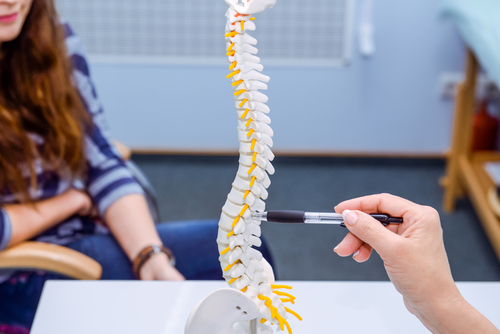High Probability of Scoliosis Surgery Found for SMA Types 1c, 2 in Dutch Study

The lifetime probability of having a scoliosis surgery is high — around 80% — for young people with SMA type 1c and type 2, a Dutch study shows. It also was high, at 71%, for those with SMA type 3 who lost the ability to walk by themselves before the age of 10.
Motor milestones not used in SMA classification, such as standing, may help predict whether a child will be likely to need a surgery, the researchers said.
This new data outperforms older studies that had smaller sample sizes, or were done at a time when genetic testing was not available. Thus, it brings new insights into the natural course of scoliosis in SMA, and may serve as a reference for assessing long-term efficacy of therapies.
The study, “Natural course of scoliosis and lifetime risk of scoliosis surgery in spinal muscular atrophy,” was published in the journal Neurology.
Progression of scoliosis, a side-to-side curvature of the spine caused by weakness in the back muscles, “is one of the most important complications” for children with SMA type 2, and for a significant number with type 3.
It impairs motor and respiratory function, with most patients eventually requiring spinal surgery for correction.
While common, the natural course of scoliosis in SMA is poorly characterized. No studies are available on the lifetime risk of scoliosis surgery in relation to disease severity.
To address this gap, researchers from the University Medical Centre Utrecht, in the Netherlands, analyzed data from 283 patients enrolled in a population-based study conducted in the country.
The study group included people with SMA types 1 through 4, with an age range of 0 to 82.2 years. Most patients (60%) had scoliosis, and 34% underwent scoliosis surgery. The lifetime probability of receiving scoliosis surgery was high: about 80% in SMA types 1c, and 2a, 2b, and 2c.
The researchers noted that SMA types can be divided into distinct subpopulations within the broader SMA types. These subpopulations, namely types a, b, and c, depend on the severity of disease, or on the achievement of motor milestones before or after a certain age. For example, type 1a is considered the most severe within type 1. Meanwhile, type 2 can be differentiated based on whether the child masters sitting independently later than 8 months of age, which is type 2a, or before 8 months of age, which is type 2b.
Overall, in SMA type 3a, the probability of receiving scoliosis surgery was 40%. For those with SMA types 3b and 4, the probability of surgery was very low. Only one of 44 patients with SMA type 3b (2%) needed surgery, and none of the six people with type 4 did.
However, for type 3a patients, the risk of surgery was strongly affected by the age at which independent walking was lost, called loss of ambulation. Among those who lost the ability to walk by themselves before age 10, 71% received surgery. Meanwhile, just 22% of those with loss of ambulation later on needed surgery.
According to researchers, these observations can be explained by the fact that “progression of weakness not only leads to loss of ambulation but also increases the risk of scoliosis progression that ultimately requires surgery.”
In these patients, one year of walking ability corresponded roughly to a 15% decrease in lifetime risk of scoliosis surgery. “Thus, long-term preservation of the ability to walk may significantly lower the lifetime probability of scoliosis surgery,” the researchers said.
Researchers also noted that children with SMA type 2a who only learned to sit — and not to stand — needed surgery at younger ages than those with type 2b, who learned to both sit and stand.
Together, these data highlight that the achievement and loss of motor milestones are associated with the need for, and timing of, scoliosis surgery. Using developmental stages, including rolling and standing, which are not part of the SMA classification system, “is of additional predictive value,” the researchers said.
Median ages at scoliosis surgery differed between SMA types. For type 1c, the median age was 14.6 years. It was 9.6 years for type 2a, and 13 years for type 2b, the study showed. For patients with SMA type 3a who lost ambulation before age 10, the estimated age was 14.3 years.
To assess scoliosis in more detail, and to study its natural progression in people with SMA, the researchers also studied 36 patients who received surgery at their center. They found that scoliosis slowly worsens at the beginning of the disease course. However, upon disease progression, it accelerates in the two years to 18 months before surgery.
“Combined, these data reflect the natural history of scoliosis development in SMA,” the researchers said.
“Although standardized and longitudinal follow-up studies of scoliosis in patients with SMA will remain necessary, our data may be helpful as a reference for assessing long-term effects of therapy,” they added.







